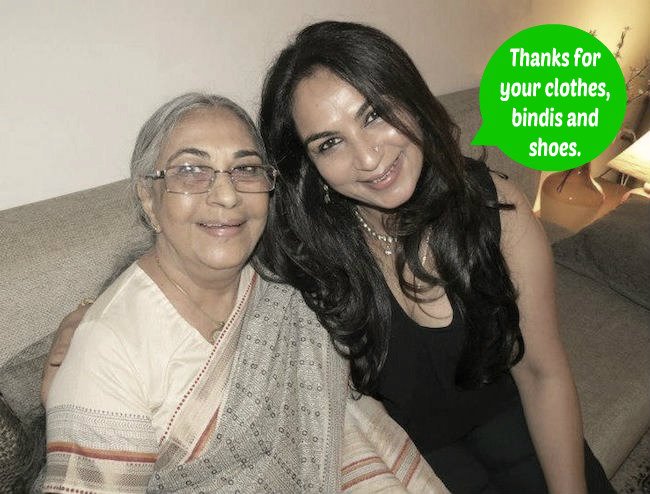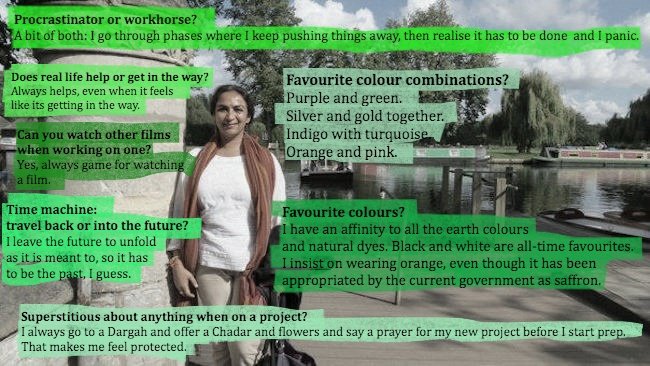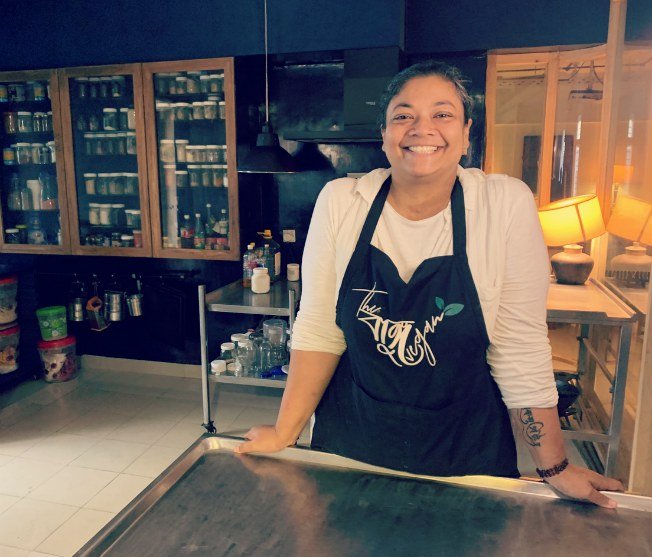Inspire Me: Himani Mehta Dehlvi
Himani Mehta Dehlvi is a costume designer I’ve had the fortune to work with on The Guru and The Bourne Supremacy.
Her long list of film credits also include Bhopal Express (costume designer) Monsoon Wedding (wardrobe mistress) and Bride & Prejudice (wardrobe supervisor). Her work has taken her from Rwanda for the feature Beyond The Gates (aka Shooting Dogs) as supervisor and to the Royal Shakespeare Company in Stratford-upon-Avon, where she designed costumes for Iqbal Khan’s adaptation of Much Ado About Nothing. She also writes, directs, produces, production designs and acts.
I chat with her about her process of designing costumes.
Background
Tell us about the early days.
When I was growing up, I’d use the hot summer afternoons while my mother was at work to play with her dupattas, costume jewellery, bindis and high-heeled shoes. The time I spent with my father [Tyeb Mehta] in his studio watching him paint gave me a sense of colour and aesthetics.
I have an older brother who started an amateur theatre group with his friends. I hung around them, watched the rehearsals and made endless cups of tea and coffee (I was called to do the odd jobs since I was 10 at the time). I also did the work of a seamstress – mending and putting together the costumes, and dressing the actors backstage.
As I grew older I decided I enjoyed acting as well, so the connection with theatre continued. After my Masters [in Sociology] from Bombay University, I moved back to Delhi to live on my own and earn my living. This wasn’t easy but I was willing to do any job that helped me pay the rent. Much to my relief, I got a job as a costume assistant for a television series written by Arundhati Roy and directed by Pradip Krishen. It was a period piece that I thoroughly enjoyed working on.
I had an affinity to fabrics, while my studies in sociology gave me an understanding of people and society, all of which are important for cinema.
How did you get on your first film?
I was married with two little boys and living in Delhi. Out of the blue, an old theatre friend from Bombay called and asked if I was interested in a film job. It was a foreign production [Holy Smoke] and she needed an assistant. I said, why not! Following that, I went on to become wardrobe mistress, then wardrobe supervisor and then costume designer.I was very fortunate to work as an assistant and supervisor to many talented costume designers at the start of my career. Their meticulous planning, attention to detail, where to push and where to let go – they all taught me a lot.
The groundwork
How do you work out the way a character may dress?
When I read a script for the first time, I note how the characters speak, where they live and what they do. I generally find myself building a back story for them, outside the realm of the script. There are always multiple ways of designing a film, and the vision of the director, production designer as well as the director of photography are key to my decisions. Generally, though, I always value my first impressions the most.
How do you pull together an overall look for the film?
I get a sense of the tone of the film from the script. The setting also guides me – a rural or natural setting, or a big city. Then I put together a colour palette to set the tone, which defines the mood of the film. Non-verbal communication is of supreme importance; colours communicate so much and if they are correct for the emotions of the film, they help tell the story. This is why some films work so beautifully even when not much is said. Light and colour play a big part.
What are all the elements you use to create a look?
The shape and silhouette of a body is important to create a character. So too is every element of what goes on the body: shoes, belt, a particular piece of jewellery. Even the way a costume is worn and carried by an actor is important to the story.
I also consider the audience. A world is being created and they will experience it as a whole when watching the film. One defining item in an actor’s wardrobe can help the audience easily understand the character – for example, a black shawl or a red hoodie can define the character in the mind of the audience. That’s why the cape of a superhero is important. An actor who internalises the character can use the costume to huge advantage by making it his or her own, rather than its being an external element.
Preferred system for planning – sketches, notes, wall charts?
I can’t sketch to save my life! I use photo references and mood boards, and build my story with fabric swatches as well.
How much of this changes when you speak to a director?
I’ll rework my notes if the director is on a different page, but mostly I find that with the kind of projects I work on, there is similarity of thought. That’s the exciting part – the trust is very important.
How does it all come together?
After an initial discussion with the director about the look and feel of the film, I do a breakdown of the script, create a timeline and a character graph for costumes.
The next very important element is the casting. So much of what a costume does is dependent on who wears it, just as an actor is helped by the costume and look we give. It also helps to discuss the look with the actor, because they come with their own interpretation and that opens up huge possibilities. I listen and absorb.
Then comes the actual production of the costumes: fabric, colour, tailoring, embellishing, breaking it down to look like someone’s clothes and not just garments on a body. (That really puts me off when I’m watching a movie!) We also age the costumes using dyeing, sandpapering and staining.
How much do you make from scratch, and how much is pre-made then modified?
It depends on the script, but mostly a bit of both. Unless it is set in a period where you can’t buy off the rack. For the TajMahal IMAX shoot, I had a great time researching, and then making everything, including footwear and turbans. That was a dream job.
Making turbans again... this time for an ad for Emirates Airlines.
What happens at a fitting? Is it any different if it’s a major star?
Typically, I line up a few options, have the actor try them on, and keep tweaking until I am satisfied and the actor likes it too. Then we take photos to show the director.A major star can be easy or a diva, depending on their personality and how seriously they take the process. I respect actors who appreciate the value of costumes.
Your relationship with actors can be quite intimate – you’ll be the first to know when they gain or lose weight, for example – how do you like to handle these relationships?
It is very personal, and can get very emotional, even tiring at times. They need a lot of pampering and encouragement because they can be fragile. I love interacting with them and giving support when required, and fading away when not. I find having positive energy within my department is very important.
On a film set
Favourite clothes while working?
I wear jeans or cotton pants with a kurta, and a scarf or dupatta as a multi-purpose garment – covers the head, protects against the sun, wipes off the sweat. It also helps in conservative places.
Who are the people you usually have on your team, and what are their roles?
Costume assistants, usually two, who help from the prep stage onwards: planning, shopping, ageing, tagging all the costumes according to characters as well as scenes.
A wardrobe supervisor comes in later, often a few weeks before filming starts, to understand the film and record everything that will be required for every scene in a systematic way, by character and by scene, so that anyone looking at this log can run the show. The supervisor also helps keep continuity, which may be required for re-shoots.
Tailors work through prep to make the costumes. They stay on through filming for alterations and making more costumes where needed.
Dressmen are usually hired a few days before filming to iron, pack, load and unload the costume truck, and do the washing after every day. And extra dressmen are hired for big scenes to help dress the extras and crowds.
How do you set up your space for a shoot?
The wardrobe base is equipped with space to iron, wash, dry and tailor costumes. We have rails to hang costumes on hangers, and tag them according to the scenes for the day. There’s a desk to log the day and prep the next. Also, where affordable, a photo printer to keep photos for continuity on set. Air-conditioning is great when we get it.
Is there a routine you follow?
When I arrive on location, I go straight to the truck or the base and line up the scenes for the day. If the cast is in makeup, the costume has to be ready in their trailer for them to change into, with someone standing by to help if it’s a major actor.I check on the extras, and pass the costumes over to them. While they’re getting ready, I have breakfast. I try to rotate my team so we take turns eating and prepping.Then I go on set and chat with the first AD [assistant director] to get a sense of how close to shoot the crew is, so I can judge how much time we have.Then it’s back to base to make sure everything is running smoothly. I like walking the actor to set for the first shot of the day, and I wait for the first ok take.
Do you prefer to be on set during the shoot?
Yes, always. I am superstitious about leaving and something going very, very wrong!
Is the shoot usually fun or stressful?
Super fun!
Your favourite part of the film process: prep, shoot or wrap?
Prep and shoot. The wrap is sad – I hate goodbyes.
Theatre
When you worked with the Royal Shakespeare Company, how did that experience differ from your film ones? What was the process like?
Theatre is so different from film. I have to constantly remind myself that there are no retakes, so the planning has to be perfect. I have to combine creative choices with practical considerations. For example, the time needed for a costume change has to be precisely worked out during rehearsals before finalising an elaborate costume change.
My brain also tends to work in terms of long shots and close-ups, and the team would double up laughing when I – very seriously – described something in cinematic terms, forgetting we were doing a play. I learned soon enough, though.
The RSC has a fabulous costume department and everyone worked really hard to do their bit to help me achieve the final result. I enjoyed sitting through preview shows and making notes, then again after the show to improve it for the next day. It was fantastic team work.
Is a stage costume bolder than it would be in real life?
It can be, depending on the performing space and how close the audience is to the actors. For Much Ado, the costumes had to be “readable” from 3 floors above, as well as to the audience that came up on stage. So, close up and long shot in the same frame.
Tell us, really
Because everyone wears clothes, do people think they can give you advice on how to do your job?
Yes! Very often.
Do you notice people’s clothing in real life and make notes for future projects?
All the time – I remember most events by what people wore.
Do you ever get the urge to make over someone in real life, or see them as characters in a film, and wonder what story they’re telling?
Hmm… not unless someone expresses asks for it.
When you watch a film or play, are you always noticing their costumes? Is there anything you find distracting?
Not always. I think I only notice when something looks jarring to me. When it is right, true, honest, it works and tells the story so I don’t think about “costumes”.
You’ve worked on a range of films – Hollywood, mainstream Hindi, indie. Does your process change depending on what type of film it is?
Yes, the scale of the film, the money available, and the time I’m given to achieve everything varies, depending on whether it’s a big studio or an indie film. I have worked on a film with months of prep with a big crew and funds to do things in an ideal way. I have also done films where I’ve pulled out my mother’s saris and my own clothes to dress the cast, worked from home and did the ironing, washing, etc myself with no resources to hire a crew.
Is designing an emotional or intellectual experience for you?
Very much both. It has to be.
Is there a genre or period you’d love to do?
I am very attracted to the Mughal/Rajput period, as well as pre-Partition India. Researching and recreating another era would be challenging and exciting. As for new genres, I would love to do a magic realism/fantasy film set in no particular time, where I can create a world of my own.
What is the most satisfying aspect of your job?
Seeing what I create coming alive on screen – it’s exhilarating! And meeting at least one person on each film who becomes a close friend.
What’s your next project?
Costume consultant for Dara at the National Theatre in London.
And finally
What have you learnt now that you wished you knew when you started designing?
The one thing I learned over time is that nothing on a film is a matter of life and death. Being a perfectionist is great, but there comes a time when you have prepped and planned and given it your best; now you need to let it go. If something goes wrong or differently than planned, think on your feet and make it work another way. It’s not the end of the world.
Himani Mehta Dehlvi Recommends
Jazz musician Pat Metheny always helps me feel good. There is so much soul in the music, I connect emotionally to all his work. I love his album [with Lyle Mays] As Falls Wichita, So Falls Wichita Falls.
As Good as It Gets is a very beautifully made film with amazing performances and nuanced characters.
I saw Ansel Adams’s photographs recently and was blown away by the originals. I had only seen reproductions until then.










